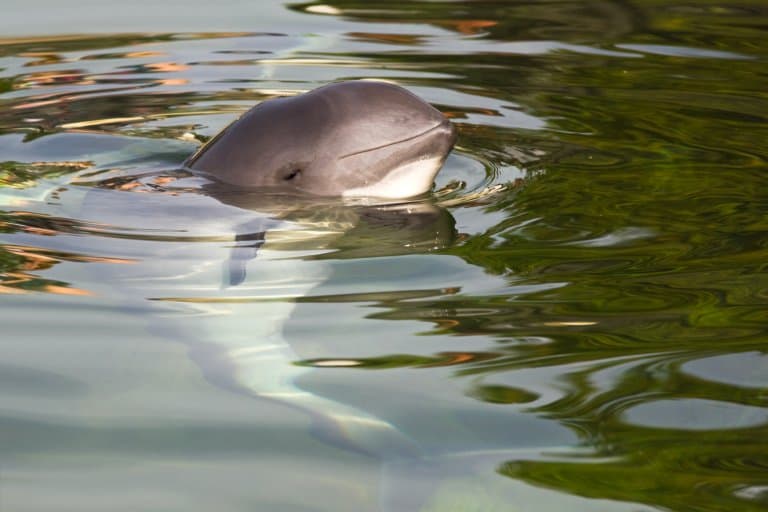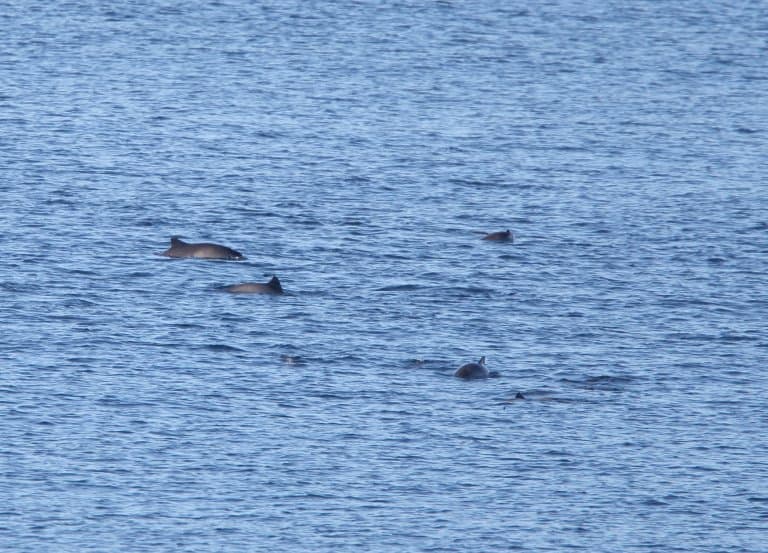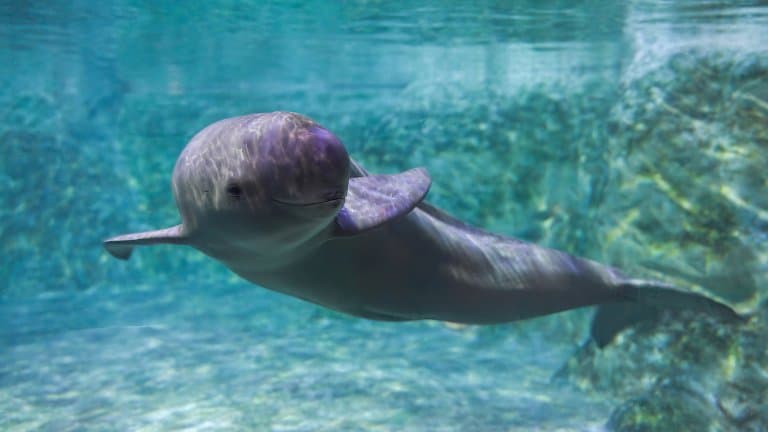Porpoise Profile
Porpoises are small, toothed whales, similar in shape to dolphins, but more closely related to their Arctic cousins.
This creature probably has the highest joke-to-humour ratio of any animal on earth. And that seems a pity, because it’s facing some very real threats to its existence and deserves to be treated seriously. Destructive commercial practices have led to some species becoming the most endangered animals on earth.
These intelligent, often-overlooked cetaceans need our help, and even if only one reader becomes inspired to pay closer attention to their consumption habits as a result of this piece, hopefully, we can rest assured that it’s served a porpoise.

Porpoise Facts Overview
| Habitat: | Coastal waters, rivers |
| Location: | Worldwide |
| Lifespan: | Up to 20 years |
| Size: | Usually under 2.5 m (8.2 ft) |
| Weight: | Up to 220 kg |
| Color: | Gray |
| Diet: | Fish, squid |
| Predators: | Sharks, Orca |
| Top Speed: | Unknown |
| No. of Species: |
8 |
| Conservation Status: |
Least Concern – Harbour porpoise, Spectacled porpoise, Dall’s porpoise. Near Threatened – Burmeister’s porpoise. Vulnerable – Indo-Pacific finless porpoise. Endangered – East Asian finless porpoise. Critically Endangered – Yangtze finless porpoise, Vaquita. |
Porpoises can be found in many environments, both rivers, as well as open oceans, and in tropical and polar waters depending on species. There are 8 species of porpoise from 3 genera, all of which are among the smallest of the toothed whales.
They can range in size, from the largest species, the Dall’s porpoise, at 2.3 m (7.7 ft) in length and 490 lb (220 kg) in weight to the smallest, the vaquita, at 1.4 m (4.7 ft) and 119 lbs (54 kg).
Porpoises have a rather bulbous head and a torpedo shaped body, and while their appearance is like a dolphin, they lack the beak often seen in dolphin species. They have a thick layer of blubber under their skin, which keeps them warm in the cold waters.
They like to feed largely on fish and squid, and they are thought to follow the migrations of bait fish such as sardines and capelin.
They’re humble little things, keeping mostly to their small groups, and speaking in clicks and grunts, rather than whistles.
Sound defines much of life in the porpoise world, and they use it to navigate their world as well as to chat with one another. What they’re saying still remains a bit of a mystery and one which will never be solved if we continue to pay corporations for reckless and unsustainable fishing practices.
Interesting Porpoise Facts
1. They have a form of locomotion named after them
Mammals have one disadvantage compared with fish when it comes to swimming fast: they need to stay near the surface to breathe. While swimming slowly, they can stay deeper in the water, coming up for air only occasionally, but when travelling at speeds of over 16 kph (10 mph), they need to be able to take longer breaths more often.
Many mammals accomplish this by leaping out of the water, maintaining the majority of their speed, and giving them time to take a deep breath. This is known as porpoising and by doing this, they’re able to maintain high speeds for prolonged periods and can cover great distances.
Interestingly, the extra energy put into leaping out of the water is offset by the reduction in friction in the air, making it an extremely efficient form of locomotion. Penguins, dolphins and even seals are known to do this, and it’s thought that the technique also makes it harder for predators to zero in on an individual when hunting. 1

2. They’re more closely related to narwhals than dolphins
Speaking of dolphins, porpoises are remarkably similar-looking. They’re generally smaller and have rounded faces, whereas a dolphin has more of a snout, and their dorsal fins are usually short and rounded (or sometimes non-existent), compared with those of a dolphin. While they’re in the same order (along with baleen whales and orca), porpoises are more closely related to narwhals.
So next time you hear a terrible dad joke with dolphin and porpoise used synonymously, you’ve got a taxonomic excuse to tell them it’s not funny. 2
3. They make small groups
Another striking difference between dolphins and porpoises is that while dolphins often form pods of hundreds (and in some cases, thousands!), porpoises are usually either solitary or stick to small family groups.
Porpoises don’t live as long as dolphins either, reaching sexual maturity at the tender age of 3, and rarely surviving past 20. In contrast, dolphins are still babies at 3 and live for roughly to 40-90 years.

4. Porpoises have only one blowhole
To breathe, they need to expell air through their blow hole, which forms steam like a chimney, before inhaling air into their lungs.
5. They sleep with half a brain
While all animals need to sleep, porpoises engage in an unusual way of sleeping where only half of their brain sleeps at a time. This is known as ‘unihemispherical sleep’.
The other half of their brain is awake, as they can’t afford to fall into full sleep, as they would drown.
The half of the brain that is awake keeps them moving, and vitally – breathing.
In particular, research shows that parabolic dives where there’s reduced bioacoustic activity might be when porpoises are half asleep. 3
6. Porpoises see like bats
Echolocation is a great way to visualise your surroundings if you’re in the dark. Porpoises, like other toothed whales (and bats), emit a high-frequency series of pulses, which are reflected back to their ears to paint a picture in the animal’s mind of where everything is.
It’s thought they might be capable of using high-energy pulses to stun their prey, as has been seen in their dolphin cousins, but this isn’t established yet.
So, they use this sound to navigate and to forage for food, but they also use sound for communication.

7. They use their fat to talk
So, sound is important to Porpoises and they’re very sensitive to it. Even the noise of a rainy day can stress them out.
To talk, they can beam acoustic signals from the melon in their head out through the nose for targeted echolocation and communications. By using a few bizarre quirks of their physiology, sounds can be heard in the throat, and then resonate in different ways, being reflected and concentrated in the blubber and in dome-like air pockets, into the ear.
Porpoise vocalisations are thought to be less complex than those of a dolphin, the latter of which has a wide range of clicks and whistles. Porpoises don’t generally whistle, except when very young, and so, in at least one case, a dolphin has been found to adjust their speech to interact with porpoises in their language.
Cetacean language is aggravatingly underfunded as a research focus, despite all the money spent looking for intelligent life off-planet. It’s obvious that there is a world of intelligent life just off our shores, with dialects, self-expression, and even inter-species conversations.
Meanwhile, some of the most intelligent animals on earth are at risk of extinction from destructive human fishing practices. 4
8. Sound may also be the key to protecting them
Over 80,000 smaller cetaceans are killed in nets used for commercial fishing around the world each year. Two species of porpoise in particular are in urgent need of protection.
These elusive animals are hard enough to find without being decimated by corporations supporting unsustainable global eating habits, but with population collapses looming all over the world, it’s getting even harder to gather the necessary data to help.
Gill nets are by far the worst offenders. The narrow fibres that make up these nets are too small to be resolved with the built-in sonar of the porpoise, and they regularly swim right into them, drowning as they struggle to free themselves.
One study has demonstrated that by using active acoustic alarms, it’s possible to warn cetaceans of the presence of nets and help them avoid the areas of highest risk. This is a relatively desperate measure that won’t serve any of the fish or invertebrates equally threatened by overfishing, but it’s a response to a desperate time in which at least one species of porpoise is on a knife’s edge. 5
9. There may be fewer than 10 Vaquita porpoises left in the world
Vaquitas are the smallest of the porpoises, at under a meter and a half in length. Over the course of the 2010s, 98% of their population disappeared. They’re killed by shrimping nets of the Gulf of Mexico; the product of which is predominantly consumed by customers in the US.
As a result of illegal levels of by-catch, the number of Vaquitas left may be as low as ten or fewer. And they’re not the only ones. The finless Yangzee river porpoise seems to be on a similar path to extinction.
The solutions can’t come fast enough, and while companies and regulatory bodies aim to placate activists with ineffective and unenforced control measures, many researchers are desperately calling for blanket bans on fishing in certain areas, and the construction of reserves to prevent the otherwise inevitable disappearance of yet another intelligent species.
Time after time, it’s been shown that if threatened species are left alone for just a short while, their populations can skyrocket. This is doubly true of ocean species. Still, there’s no recovery from extinction, and each species we lose due to human devastation represents the untimely end of a 3.7-billion-year unbroken chain of evolution.
We’re losing animals faster than we’re discovering them, and each loss accelerates a mass extinction event that we are affected by. The primary reason is one we are all complicit in: our overconsumption of unsustainable resources for simple pleasure.
Without the demand for seafood, the oceans would bounce back in a heartbeat. At the very least, it should be everyone’s responsibility to research the sources of the food we eat, and to take steps to live more in harmony with the environment we rely on. 6
10. Killer whales like them for lunch
While porpoise are intelligent and fast creatures, they do have a couple of fierce predators in sharks, and orcas.
Orcas in particular have a formidable array of hunting strategies and will hunt down porpoises.

Porpoise Fact-File Summary
Scientific Classification
| Kingdom: | Animalia |
| Phylum: | Chordata |
| Class: | Mammalia |
| Order: | Artiodactyla |
| Infraorder: | Cetacea |
| Superfamily: | Delphinoidea |
| Family: |
Phocoenidae |
| Genera: |
Neophocaena Phocoena Phocoenoides |
| Species: |
Neophocaena
N. phocaeniodes – Indo-Pacific finless porpoise Phocoena P. phocoena – harbour porpoise Phocoenoides P. dalli – Dall’s porpoise |
Fact Sources & References
- D. Weihs (2002), “Dynamics of Dolphin Porpoising Revisited“, Integrative and Comparative Biology.
- “Harbor Porpoise“, The Whale Trail.
- Andrew J. Wright, Tomonari Akamatsu, Kim N. Mouritsen, Signe Sveegaard, Rune Dietz, Jonas Teilmann (2017) “Silent porpoise: potential sleeping behaviour identified in wild harbour porpoises“, Animal Behaviour.
- Elizabeth Anne Brown (2022), “For the first time, wild dolphin observed ‘talking’ with harbor porpoises“, National Geographic.
- Kraus, S., Read, A., Solow, A. et al (1997), “Acoustic alarms reduce porpoise mortality“, Nature.
- Gabrielle Canon (2022), “There are fewer than 10 tiny vaquita porpoises left. Can they be saved?“, The Guardian.
